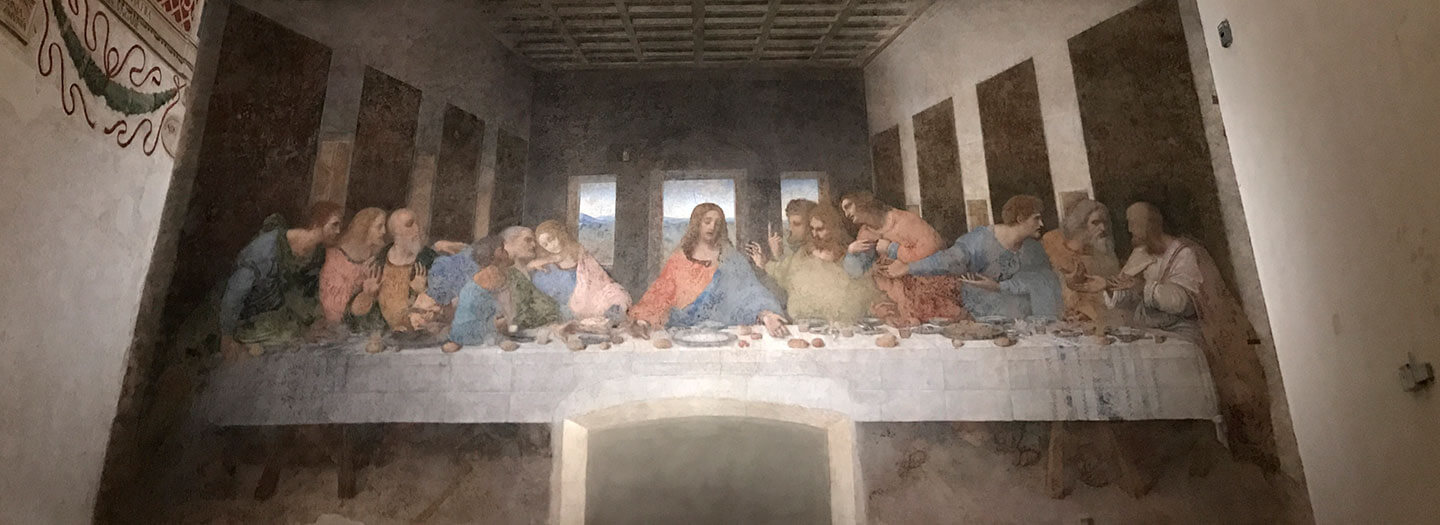
In this May 16, 2017 photo, Leonardo da Vinci's "The Last Supper" is seen in Milan, Italy. (AP Photo/Courtney Bonnell)
When you think of Jesus’ last supper with his disciples, what image comes to mind?
If you’re like most of us, you think immediately of Leonardo da Vinci’s famous painting. Its iconic depiction of our Lord at the center of a long table, his disciples seated on his left and his right, has for centuries been the way Western culture views this biblical event.
Leonardo’s fresco was completed around 1498 for the Dominican monastery Santa Maria della Grazie in Milan, Italy. It is in the news today since it was on this day in 1999 that the masterpiece was opened for public display after more than twenty years of restoration.
The painting began to deteriorate soon after it was completed, suffering from the steam and smoke of the monastery’s kitchen, soot from the refectory’s candles, and the dampness of its location. In 1652, a door was cut into the wall on which the painting was made, removing Jesus’ feet and loosening the paint and plaster.
Napoleon’s invading troops used the refectory as a stable, further damaging the painting. After a nineteenth-century flood, mold corroded it as well. An Allied bomb during World War II caused the roof and one wall of the refectory to collapse. The painting survived but was exposed to the elements for several months before the space was rebuilt.
The Last Supper finally underwent an extensive restoration beginning in 1978 that took more than twenty years to complete.
The history of the painting is just one part of its remarkable story. Another is the way Leonardo chose to depict Jesus’ last meal with his disciples.
The men sit in chairs at a long, horizontal table. The back wall is dominated by three windows through which Milan’s countryside is visible.
None of this, of course, is accurate biblically or historically.
The unchanging relevance of God’s word
Meals in Jesus’ day were eaten from a platform that stood eighteen inches above the floor. The men would have laid on the ground, their weight supported by their left arm while they ate with their right hand. The table would have been U-shaped so servers could place food items on it without needing to step over the men. And of course, the last supper took place in Jerusalem, not in Milan.
These observations are not intended as a criticism of Leonardo da Vinci. The genius clearly knew that his painting was not an accurate representation of a first-century Jewish meal in Jerusalem. Rather, he chose to contemporize Jesus’ last supper by recasting it in his day and place. His masterpiece brought the event into his culture, demonstrating its relevance fifteen centuries after it took place.
One of the most significant insights I gained in seminary was the realization that the Bible does not need to be “made” relevant. Since neither human nor divine nature changes, what was true twenty centuries ago is still true today.
Rather, our calling is to remove the cultural hindrances that have grown up over the centuries so that the message of the text can be revealed to our culture. When we do this, the abiding truth and significance of God’s word reveals itself with transforming power.
For example, our culture thinks of Samaritans as “good,” thus missing the point of Jesus’ famous parable. When people are taught that the Samaritan hero of the story was despised by Jesus’ Jewish culture, the point of the narrative becomes clear and compelling.
It is still true today that “the word of God is living and active, sharper than any two-edged sword, piercing to the division of soul and spirit, of joints and of marrow, and discerning the thoughts and intentions of the heart” (Hebrews 4:12). When we explain what the text meant, the Holy Spirit uses its truth to change our hearts and lives today.
Of course, the best way to show that the Bible is relevant to our culture is to live by its truth personally. When God’s word changes our lives, others will be drawn to its transforming power. When last did studying the word of God change you?













